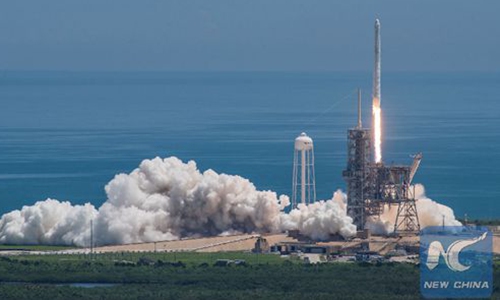HOME >> WORLD
Uncrewed ‘Starliner’ back home early
Source:AFP Published: 2019/12/22 18:53:39
Boeing’s rehearsal space flight made contact, failed to link with ISS

The photo released by SpaceX on Aug. 14, 2017 shows Falcon 9 rocket being launching at NASA's Kennedy Space Center in Florida, the United States. (Xinhua)
The uncrewed Starliner capsule is now scheduled to land Sunday at 05:47 am (12:57 GMT) at the White Sands Missile Range in New Mexico.
The capsule is currently in a low, 250-kilometer orbit. Boeing engineers are programming it to re-enter the atmosphere over the Pacific Ocean.
Parachutes will slow its descent, and huge airbags will be deployed to cushion its desert landing.
Starliner's failure was the latest serious setback for Boeing, which is still reeling from two fatal crashes of its 737 Max airliner. The crashes, in October 2018 in Indonesia and in March 2019 in Ethiopia, claimed a total 346 lives.
The aerospace company plans to suspend production of the plane in January.
The Starliner capsule was launched Friday from Cape Canaveral, Florida, but shortly after separating from its Atlas V launch rocket its thrusters failed to activate as planned, preventing it from reaching an orbit high enough to meet up with the ISS.
The space station orbits at an altitude of about 400 kilometers above sea level.
After calculating that the craft had burned too much propellant for several minutes - owing to a clock problem - Boeing and the National Aeronautics and Space Administration (NASA) determined that the Starliner would have to return to Earth without fulfilling its planned mission.
The flight - carrying only a dummy into space - was meant to be a final dress rehearsal before a crewed flight.
But NASA Administrator Jim Bridenstine insisted that the mission was not a complete failure.
Thus, Starliner was able to establish a communications link with the ISS, and to test in space its docking mechanism as well as its solar panels, batteries, thrusters and heat regulation system.
Chilton said the vehicle's status is "really excellent."
But a major test awaits: Starliner's landing Sunday in the New Mexico desert - one of the most dangerous phases for any space mission, particularly when the vehicle is designed to transport astronauts.
Starliner is set to re-enter the atmosphere at 25 times the speed of sound. Its thermal shield will have to resist the intense heat created by friction with the atmosphere, and its three parachutes will have to deploy correctly.
In a test in November only two parachutes opened, although they proved sufficient for the landing.
NASA will have to decide whether to carry out another test flight or to trust that the vehicle is safe to carry astronauts.
AFP
Posted in: AMERICAS,WORLD FOCUS,EYE ON WORLD